
Overview
This article delves into effective SEM strategies designed to significantly enhance conversion rates for direct-to-consumer (DTC) brands. It underscores the critical role of data-driven approaches, emphasizing:
- User behavior analysis
- Targeted advertising
- Optimization techniques such as A/B testing and retargeting
These strategies collectively contribute to substantial increases in sales and customer engagement. Various case studies illustrate these points, showcasing significant performance improvements that reinforce the necessity of implementing these methods in today's competitive market.
Introduction
In an increasingly competitive landscape, direct-to-consumer (DTC) brands are persistently pursuing innovative methods to elevate their conversion rates. By strategically implementing search engine marketing (SEM) techniques, these brands can effectively engage their target audience and drive substantial sales growth. This article delves into ten powerful SEM strategies that not only optimize advertising efforts but also utilize data-driven insights to transform user engagement into meaningful conversions.
How can DTC brands leverage these strategies to not only attract traffic but also convert it into a loyal customer base?
Parah Group: Optimize Conversion Rates with Data-Driven Strategies
Parah Group employs a comprehensive, data-informed approach that incorporates SEM strategies to enhance success metrics for DTC brands. By leveraging user behavior analysis tools, such as session recordings and customer surveys, they identify critical areas for optimization through SEM strategies. This method is deeply rooted in , ensuring that every modification resonates with the target audience.
Notably, user-created content has been shown to boost sales by 8.5%, based on an analysis of over 1.5 million product pages from 1,200 retailers, underscoring the effectiveness of engaging customers through relatable content. Furthermore, Parah Group's SEM strategies not only improve user experience but also lead to significant increases in transaction figures and average order values (AOV).
For instance:
- A $30M clothing label witnessed a remarkable 35% increase in sales metrics following a homepage overhaul that emphasized social validation, reduced unnecessary pop-ups, and refined product pricing.
- A $15M cleaning product company achieved an impressive 80% increase in AOV by implementing bundles and free shipping thresholds.
These outcomes highlight the substantial impact of thoughtful design and SEM strategies in the context of strategic testing. By concentrating on data-driven insights, Parah Group effectively transforms user interactions into meaningful conversions, propelling growth for their clients.
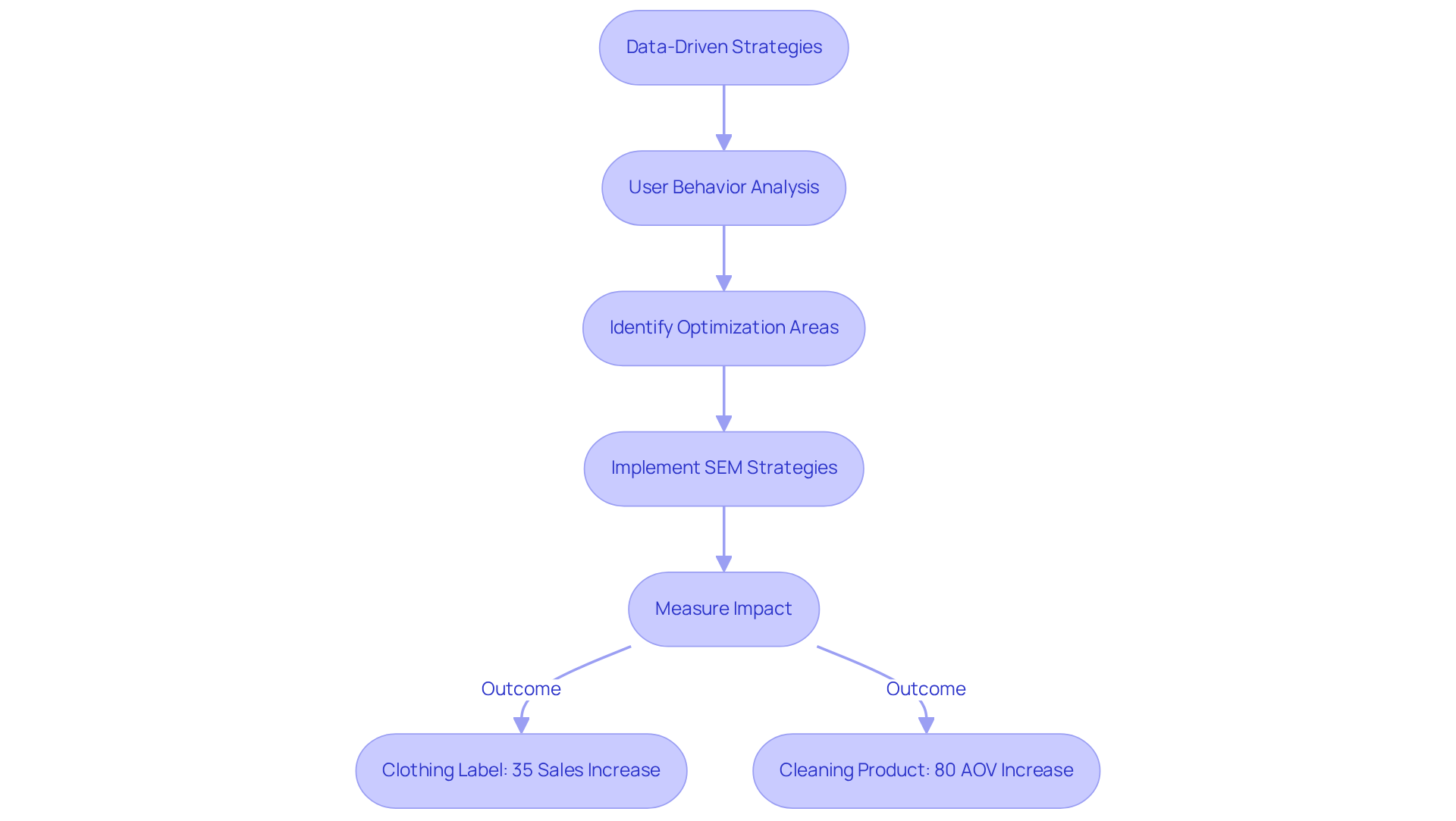
Google Ads: Leverage Targeted Advertising for Maximum Visibility
Effectively utilizing SEM strategies can significantly enhance visibility for direct-to-consumer (DTC) companies. By concentrating on SEM strategies that involve targeted keywords and demographics, brands ensure their ads reach potential customers most likely to convert. Techniques such as ad extensions and location targeting are essential SEM strategies that not only broaden audience reach but also maximize the effectiveness of advertising expenditure, driving increased success rates.
To elevate these efforts, incorporating comprehensive Conversion Rate Optimization (CRO) approaches is essential. Parah Group advocates for a holistic strategy that aligns paid ads with optimized landing pages, employing:
- A/B testing
- User behavior analysis
- Data-driven insights
to enhance ad effectiveness. This synergy not only boosts visibility but also ensures that traffic generated through Google Ads translates into significant conversions, ultimately maximizing profitability and fostering sustainable growth for DTC companies. Unlike other agencies, Parah Group prioritizes profitability and , customizing strategies to meet the unique needs of each client.
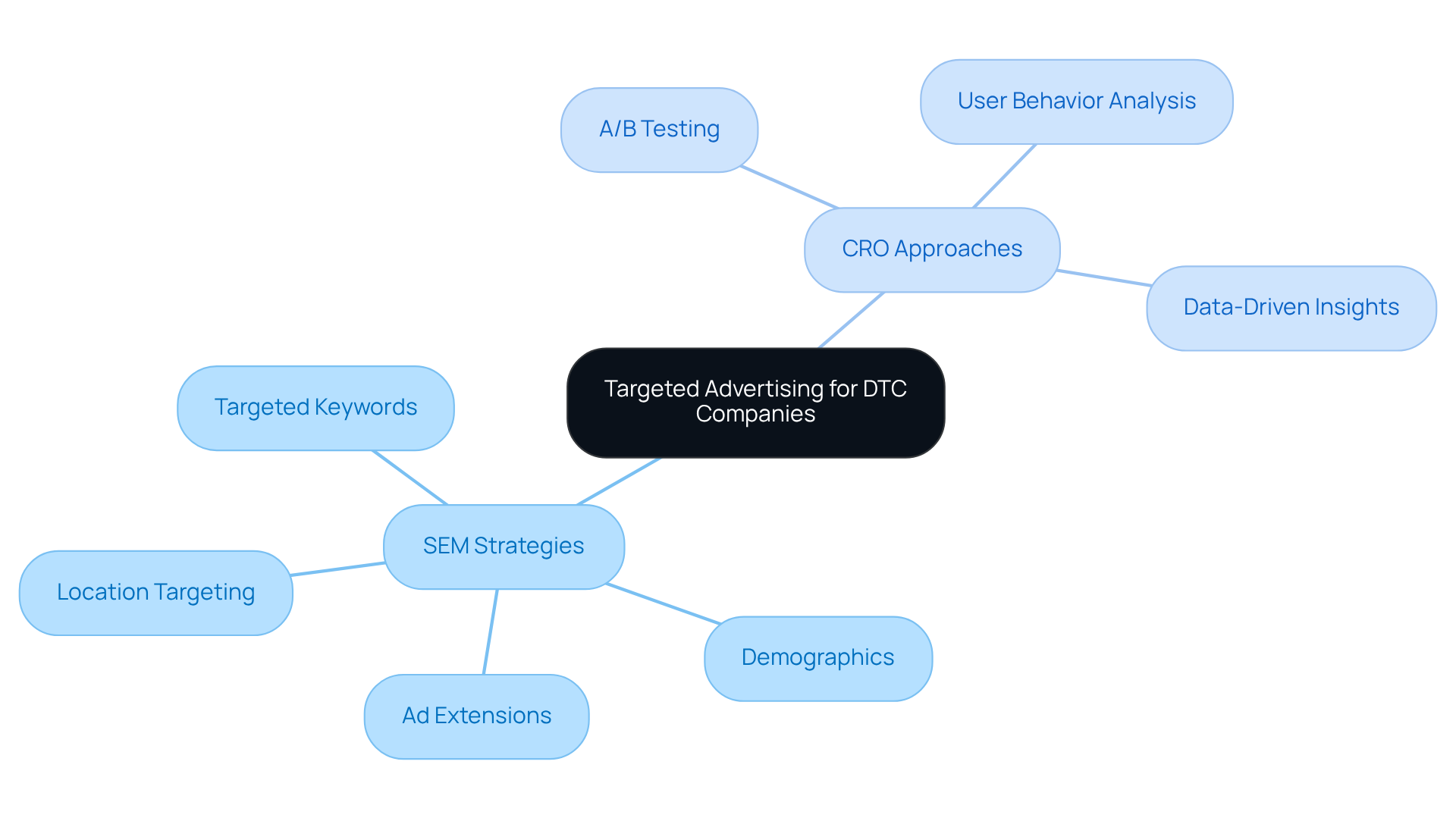
Smart Bidding: Enhance Ad Performance with Automated Bid Strategies
Smart Bidding leverages machine learning to optimize bids in real-time, empowering DTC companies to maximize the value of their advertising investments. By establishing clear objectives—such as maximizing results or achieving a specific return on ad spend (ROAS)—brands can automate their bidding processes, resulting in more efficient campaign management. This strategy not only but also allows companies to reallocate resources to other marketing initiatives.
For example, businesses that have implemented Smart Bidding report substantial profit increases; one case study highlights a remarkable 57% profit boost post-implementation. Furthermore, automated bidding strategies can reduce cost-per-click by up to 31% while enhancing conversion rates by 54%, underscoring their effectiveness in driving measurable outcomes.
As the digital advertising landscape continues to evolve, adopting these advanced bidding techniques is crucial for companies seeking to maintain competitiveness and implement SEM strategies for sustainable growth.

Dynamic Keyword Insertion: Increase Relevance and Engagement in Ads
Dynamic Keyword Insertion (DKI) is a powerful tool that enables advertisers to automatically tailor their ad text to the specific keywords that triggered the ad. This strategic approach significantly enhances the relevance of ads to user search queries, leveraging SEM strategies to achieve an increase in click-through percentages (CTR) by approximately 5-15%.
By aligning ads with user intent, DTC companies can effectively enhance engagement and drive sales. For instance, a case study from Parah Group demonstrated an impressive 18% increase in CTR following the implementation of DKI in ad headlines. Moreover, DKI has the potential to reduce cost per acquisition by nearly $100, showcasing its effectiveness in optimizing advertising budgets.
As Malay Gupta, VP of Growth & Operations at Growleads, asserts, 'DKI remains relevant in 2025 when used strategically.' This underscores the necessity of careful implementation to maximize benefits while avoiding potential pitfalls.
Ultimately, leveraging DKI within SEM strategies not only but also fosters deeper connections with consumers, leading to improved conversion rates and overall marketing success. The methods demonstrated by Parah Group in Conversion Rate Optimization further illustrate how DTC companies can enhance their profitability through innovative approaches, ensuring that every marketing dollar spent contributes to sustainable growth.
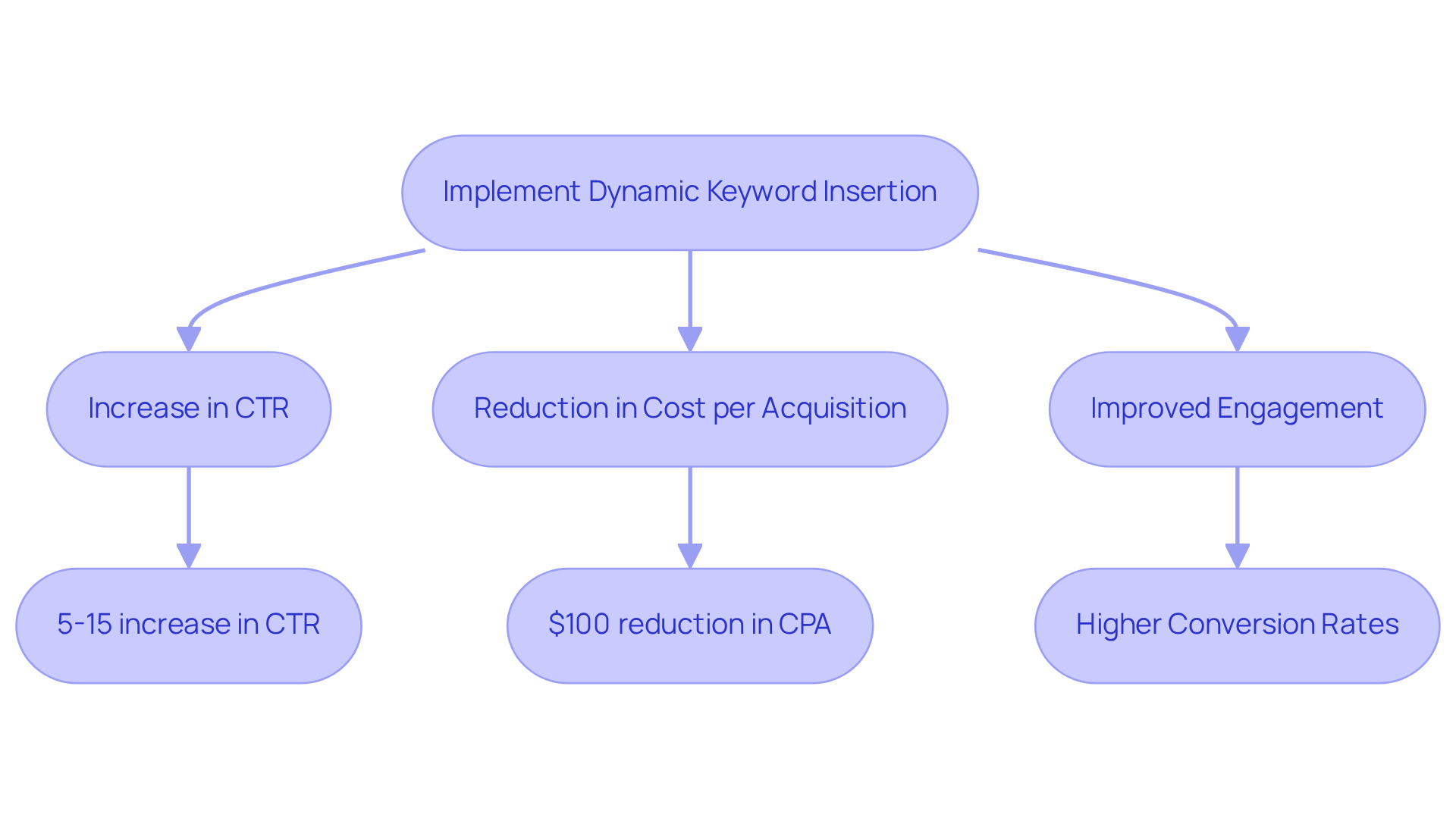
Competitor Analysis: Uncover Insights to Outperform Rivals
Conducting a comprehensive competitor analysis is paramount for DTC companies seeking to secure a competitive edge. By leveraging advanced tools that monitor competitors' advertising effectiveness, keyword strategies, and SEM strategies, companies can uncover critical insights into their rivals' strengths and weaknesses. Notably, a study revealed that approximately 75% of leading online retailers employ A/B testing platforms, underscoring the necessity of continuous optimization to maintain a competitive advantage. Furthermore, companies can identify market opportunities that competitors may overlook, allowing them to refine their strategies effectively.
Case studies vividly illustrate the impact of these insights:
- Hotel Institute Montreux achieved a remarkable 50% increase in form submissions by strategically positioning testimonials above their lead generation forms, exemplifying how competitor insights can inform impactful design decisions.
- Similarly, EcoFoil realized an impressive 86% increase in purchases through targeted strategies that capitalized on competitor vulnerabilities.
This proactive approach not only enhances performance metrics but also fortifies a company's position in the market. Thus, it is essential for DTC companies to , such as competitor monitoring tools and analysis, to drive sustained growth.
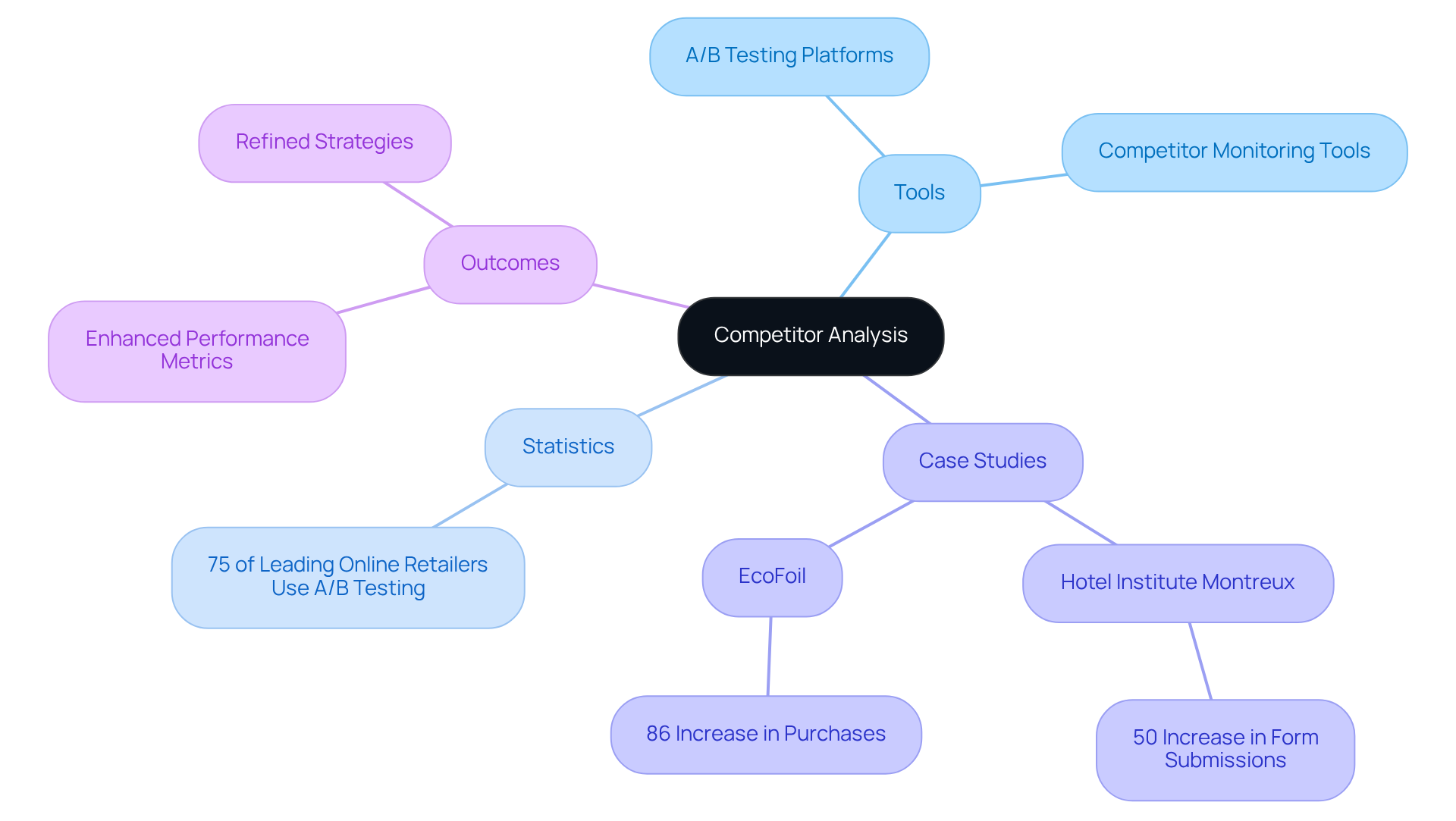
Long-Tail Keywords: Capture High-Intent Traffic for Better Conversions
Long-tail keywords represent specific phrases that potential customers utilize when they are approaching a purchase decision. By strategically concentrating on these keywords, DTC brands can effectively attract high-intent traffic, significantly boosting their sales potential. Incorporating long-tail keywords into advertising campaigns not only enhances relevance but also diminishes competition, often leading to lower cost-per-click (CPC) amounts. This strategy has been demonstrated to yield as high as 36%, in contrast to the average of 11.45% for standard landing pages.
As Adam Audette aptly states, "Today it's not about 'get the traffic,' it's about 'get the targeted and relevant traffic.'" By focusing on long-tail keywords, companies can engage with consumers who are ready to act, ultimately driving superior outcomes in their SEM strategies.
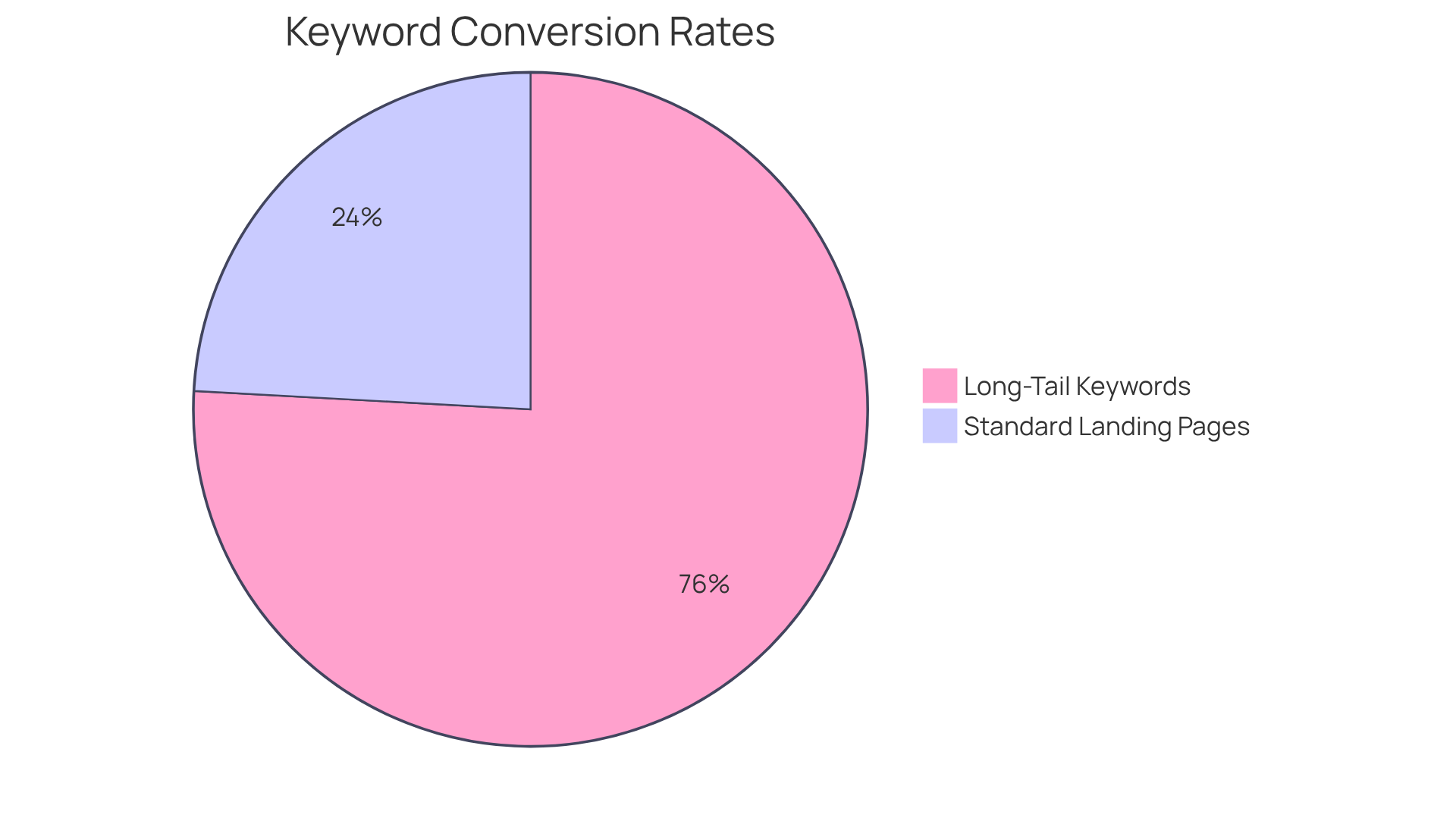
A/B Testing: Refine Strategies for Optimal Ad Performance
A/B testing stands as a cornerstone in enhancing ad performance for direct-to-consumer (DTC) companies. By comparing two versions of an ad to ascertain which performs better, companies can make data-driven decisions that refine their marketing strategies. This iterative process empowers brands to , visuals, and calls to action, ultimately yielding superior success metrics and a higher return on investment.
The significance of A/B testing is underscored in 2025, with approximately 58% of companies leveraging it to boost performance, and 60% employing A/B testing for their landing pages, reflecting a growing recognition of its value across diverse marketing channels. Effective A/B testing methodologies involve examining various elements such as headlines, visuals, and targeting options, with research indicating that even minor adjustments can lead to substantial results—evidenced by a 620.9% increase in click-through rates from optimized calls to action, as demonstrated by PriceCharting.
Notably, case studies from Parah Group reveal that companies implementing comprehensive conversion rate optimization (CRO) strategies, which include A/B testing, have achieved remarkable outcomes:
- A $30 million apparel company realized a 35% increase in conversion rates and a 10% rise in revenue per visitor after enhancing their homepage and reducing unnecessary pop-ups.
- A $15 million cleaning product company saw a 73% boost in average order value through strategic testing of free shipping thresholds and product bundles.
Marketing experts advocate for a culture of continuous testing, noting that 71% of companies conduct two or more tests each month, highlighting the pervasive nature of this practice among successful enterprises. As the marketing landscape evolves, companies that prioritize data-driven decision-making through A/B testing and SEM strategies are poised to experience increased engagement and profitability. Pratyusha Guha aptly asserts, 'Embracing A/B testing isn’t just smart; it’s essential for staying competitive.
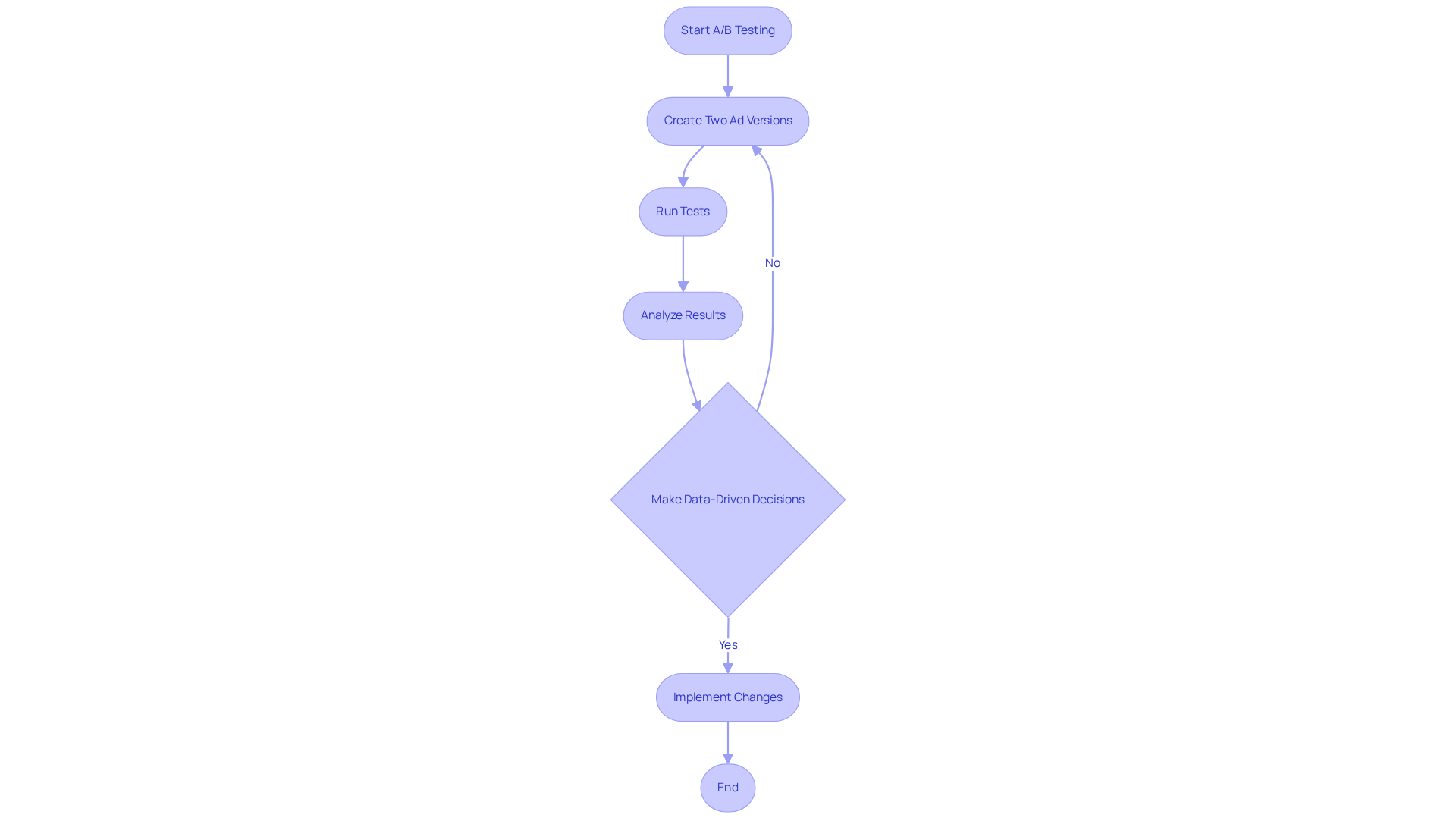
Retargeting: Re-Engage Interested Customers for Increased Sales
Retargeting serves as a pivotal strategy for DTC companies, enabling them to reconnect with users who have previously engaged with their website or advertisements. By delivering customized advertisements to these individuals, companies can effectively remind them of products they expressed interest in, thereby motivating them to return and finalize their purchases. This approach not only enhances success rates but also bolsters brand recognition and fosters customer loyalty.
Research reveals that remarketing campaigns can successfully recapture 26% of visitors who did not make a purchase during their initial visit, significantly boosting overall sales. Moreover, companies that employ retargeting strategies often experience a substantial increase in their return on advertising expenditure (ROAS), as these advertisements target individuals already familiar with the brand, consequently elevating the likelihood of conversion.
For instance, a $30M clothing label that partnered with Parah Group experienced a 35% surge in conversion rates following the implementation of a comprehensive CRO plan that included retargeting initiatives, A/B testing of various ad headlines, and refined messaging for enhanced engagement. Additionally, a DTC cannabis brand noted a remarkable 90% increase in average order value (AOV) through targeted retargeting campaigns that reminded customers of their interest in multi-packs and provided incentives such as free gifts for larger purchases. These case studies underscore the potential of retargeting not only to rekindle customer interest but also to for improved engagement through rigorous testing—an essential aspect of any CRO strategy.
In a fiercely competitive e-commerce landscape, where consumers increasingly seek personalized experiences, retargeting emerges as a potent tool for driving conversions and maximizing sales potential. By focusing on users who have previously demonstrated interest, DTC companies can craft a more effective and persuasive marketing strategy by utilizing SEM strategies that yield sustainable growth. As emphasized, "Data-driven decisions enable companies to enhance marketing strategies, minimize waste, and optimize growth potential," underscoring the importance of tracking performance metrics such as ROAS to ensure the profitability of remarketing campaigns.

Analytics Tools: Monitor Performance and Drive Strategic Decisions
Analytics tools are indispensable for monitoring the performance of SEM strategies, providing DTC companies with vital insights into user behavior, traffic sources, and conversion rates. Among these, Google Analytics and SEMrush emerge as formidable tools that empower companies to analyze data with precision.
By leveraging these tools, companies can:
- Uncover trends
- Evaluate the effectiveness of their marketing strategies
- Make informed, data-driven decisions that foster ongoing improvements in their marketing efforts
For instance, Google Analytics enables brands to identify which traffic sources yield the highest success rates, while SEMrush aids in revealing keyword opportunities and assessing competitive positioning. This data-centric approach not only enhances success rates but also facilitates the development of more .
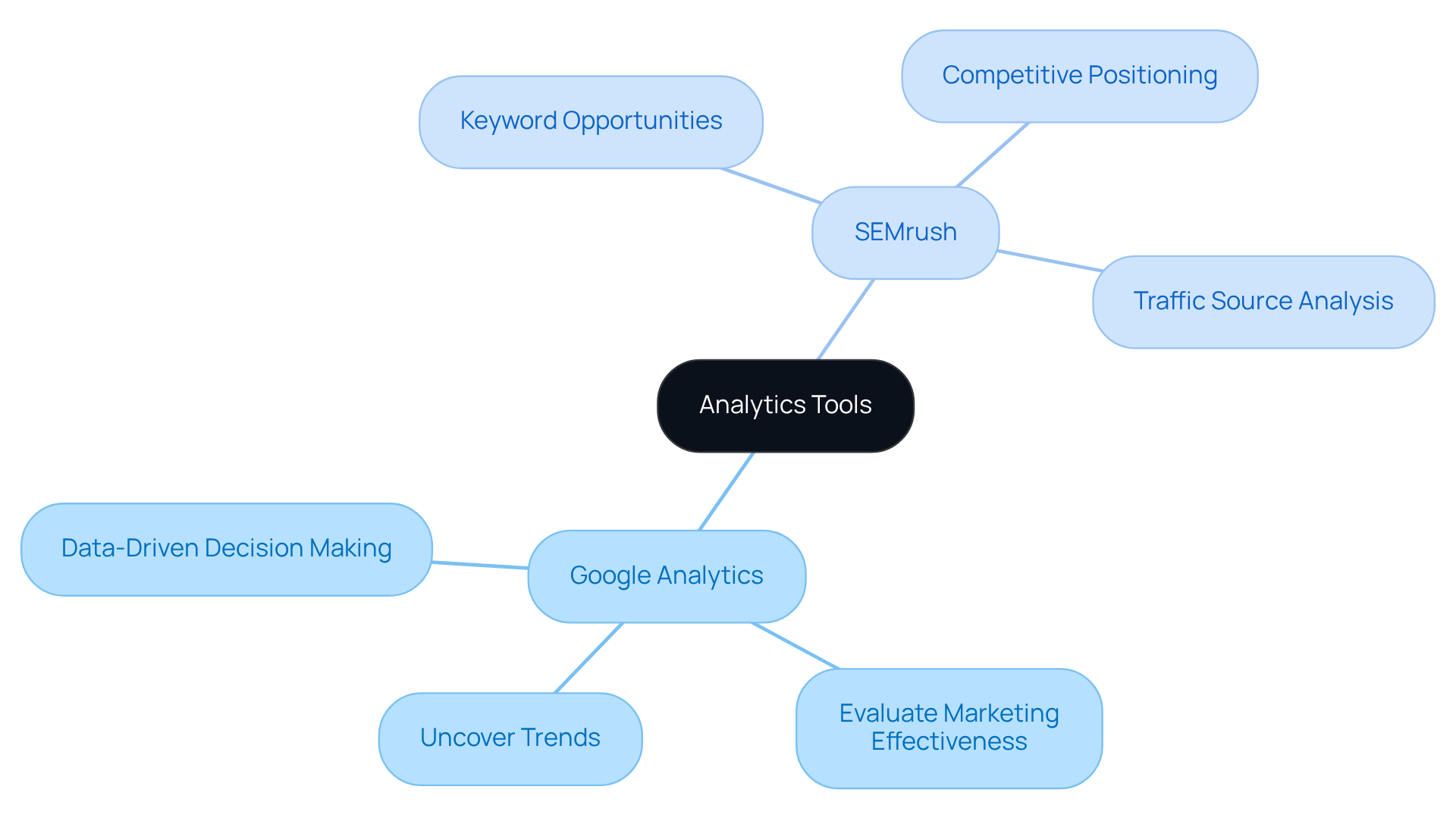
User-Friendly Landing Pages: Enhance Customer Experience and Boost Conversions
Developing user-friendly landing pages is essential for optimizing outcomes. A well-structured landing page not only features a clear call to action but also includes concise messaging and an intuitive layout that effectively guides users toward their desired actions. Moreover, optimizing for speed and mobile responsiveness is crucial; currently, only 50% of landing pages are optimized for mobile, which can significantly hinder user engagement.
Studies indicate that:
- Landing pages with enhanced UX design are four times more effective.
- Those can experience an 86% rise in successful outcomes.
- Simplifying communication to a 5th to 7th grade reading level can result in an 11% success percentage, which is 56% greater than pages composed at a more advanced level.
Successful case studies, such as the implementation of tailored landing pages for Docket, which led to a remarkable 68% rise in outcomes, highlight the effectiveness of these strategies. By focusing on these optimization techniques, DTC brands can enhance the overall customer experience, leading to increased conversion rates and greater customer satisfaction.
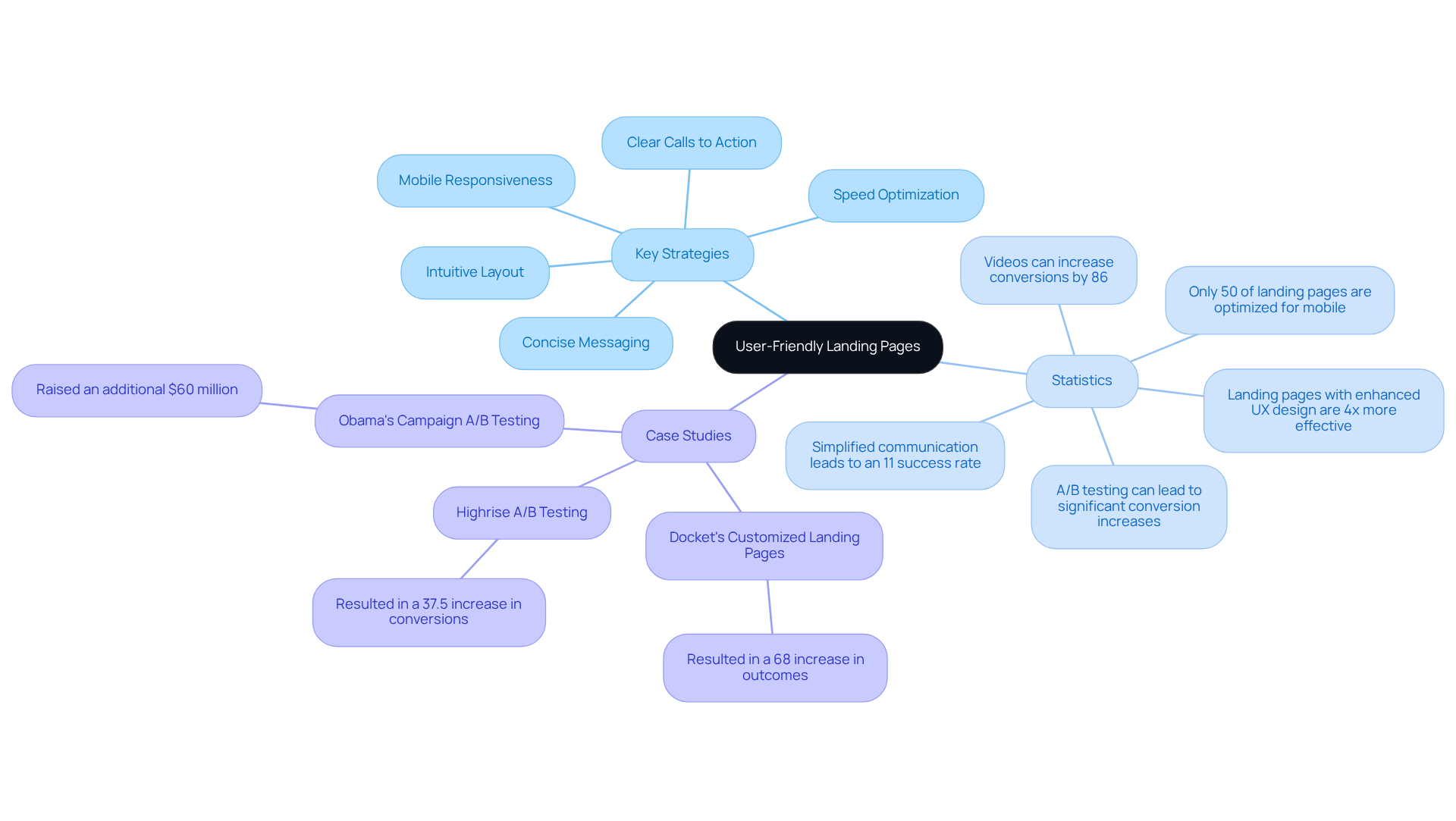
Conclusion
Implementing effective SEM strategies is essential for DTC brands seeking to enhance their conversion rates. By leveraging data-driven insights and innovative techniques, companies can optimize their marketing efforts to resonate more effectively with target audiences, ultimately driving sales. The integration of tools such as Google Ads, Smart Bidding, and Dynamic Keyword Insertion exemplifies how strategic advertising can significantly increase visibility and engagement, paving the way for improved profitability.
Key insights from the article underscore the importance of user behavior analysis, competitor monitoring, and A/B testing in refining marketing strategies. These practices not only boost ad performance but also ensure that brands maintain their competitive edge in an ever-evolving digital landscape. Case studies illustrate the tangible benefits of these approaches, showcasing substantial increases in sales and average order values when implemented with precision.
In a landscape where consumer preferences are continuously shifting, DTC brands must prioritize a comprehensive and adaptable SEM strategy. By embracing these techniques, companies can cultivate sustainable growth, enhance customer experiences, and ultimately achieve their conversion goals. The call to action is unequivocal: invest in data-driven SEM strategies today to unlock the full potential of your brand and stay ahead in the competitive marketplace.
Frequently Asked Questions
What is the main approach used by Parah Group to optimize conversion rates for DTC brands?
Parah Group employs a comprehensive, data-informed approach that incorporates SEM strategies to enhance success metrics for DTC brands, leveraging user behavior analysis tools to identify areas for optimization.
How does Parah Group utilize user behavior analysis?
They use tools such as session recordings and customer surveys to analyze user behavior, which helps in identifying critical areas for optimization through SEM strategies.
What impact does user-created content have on sales?
User-created content has been shown to boost sales by 8.5%, based on an analysis of over 1.5 million product pages from 1,200 retailers.
Can you provide examples of successful outcomes from Parah Group's strategies?
Yes, a $30M clothing label saw a 35% increase in sales after a homepage overhaul, while a $15M cleaning product company achieved an 80% increase in average order value by implementing bundles and free shipping thresholds.
What are the key SEM strategies mentioned for enhancing visibility for DTC companies?
Key SEM strategies include targeting specific keywords and demographics, using ad extensions, and location targeting to broaden audience reach and maximize advertising effectiveness.
How does Parah Group integrate Conversion Rate Optimization (CRO) with SEM strategies?
Parah Group integrates CRO with SEM by aligning paid ads with optimized landing pages and employing techniques such as A/B testing, user behavior analysis, and data-driven insights.
What is Smart Bidding and how does it benefit DTC companies?
Smart Bidding leverages machine learning to optimize bids in real-time, allowing DTC companies to maximize the value of their advertising investments and automate bidding processes for more efficient campaign management.
What are the reported benefits of implementing Smart Bidding?
Businesses that implemented Smart Bidding reported a 57% profit boost, a reduction in cost-per-click by up to 31%, and an enhancement in conversion rates by 54%.
Why is adopting advanced bidding techniques important for companies?
Adopting advanced bidding techniques is crucial for maintaining competitiveness in the evolving digital advertising landscape and implementing SEM strategies for sustainable growth.
FAQs











